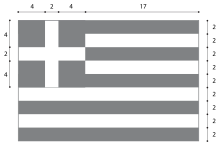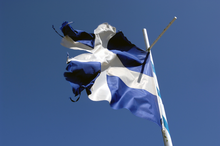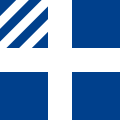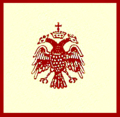Flag of Greece
| Flag of Greece | |
|---|---|
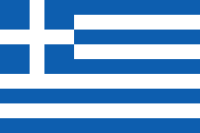 |
|
| Vexillological symbol : |
|
| Aspect ratio: | 2: 3 |
| Officially accepted: | first reintroduced March 27, 1822 December 22, 1978 |
The current flag of Greece ( Greek Σημαία της Ελλάδος Simea tis Ellados ) has been in constant competition with a simple blue flag with a white cross throughout the history of modern Greece . It wasn't until 1978 that today's design became the only national flag in the country.
Color and meaning
The national flag consists of nine horizontal stripes of equal width in blue and white. In the upper left corner there is a white cross on a blue, square background. The side of the square is the width of five of the horizontal stripes, the white cross is the width of one of these stripes.
The colors blue and white can be traced back to the Byzantine Empire . The blue varied very often. During the time of King Otto I , a medium blue was used based on the coat of arms of the Bavarian Wittelsbach family . The Greek military junta between 1967 and 1974 used a very dark blue. The current flag law speaks of a light blue. Most of the time, however, you can see the flag in an ultramarine blue , also on the website of the Greek President .
The flag is supposed to represent "God's wisdom, freedom and the land". The blue stands for the sea and the sky, white for the purity of the struggle for independence. The cross stands for the Christian tradition of Greece, which is mainly cultivated by the Orthodox Church . The nine stripes correspond to the nine syllables of the motto of the Greek war of liberation: Ε-λευ-θε-ρί-α ή Θά-να-τος E-lef-the-rí-ai thá-na-tos (German freedom or death ). Another explanation would be that the Greek word for freedom ( Ελευθερία ) has nine letters. A third interpretation is that the four white stripes correspond to the four cardinal points and the five blue stripes correspond to the five sub-seas of the Mediterranean, which border on the area that Greece aspired to in the name of the Megali Idea in the 19th century.
history
Ancient and Middle Ages
In ancient Greece there were no flags as a distinguishing mark. Instead, shields with various painted symbols were used as standard symbols. These symbols were called ἐπίσημα episēma . The sails of ships were colored and painted, the ships also had flags on their masts. They were also used as signal flags in naval battles. A red flag was the signal to attack.
Under the imperial dynasty of palaeologists in the 14th century, a flag was used that had a cross with a B in each corner. Under Emperor Michael VIII Palaiologos (1261–1282) the double-headed eagle became a symbol of the empire. It can be found today in the flag of Greek Orthodoxy . The eagle in Russia's coat of arms is also derived from it. The flag used in the 14th century was a combination of the George cross and the coat of arms of the imperial family Palaiologos.
During the Ottoman rule, the Greek merchant ships used a horizontal, red-blue-red tricolor. Red stood for the Ottoman Empire , blue for the Greeks. Smyrna , today's Izmir , used a variant with five stripes in alternating red and blue. According to the Peace of Küçük Kaynarca (1774), Greek Orthodox merchant ships were also allowed to carry the Russian merchant flag .
 ? Flag of the Byzantine Empire in the 13th-14th centuries century
? Flag of the Byzantine Empire in the 13th-14th centuries century
 ? Flag of Greek merchant ships in the Ottoman Empire
? Flag of Greek merchant ships in the Ottoman Empire
Greek small states
In 1800 the originally Venetian Ionian Islands became the first modern Greek state, the Republic of the Ionian Islands . As a flag, it took over the lion of St. Mark on a blue background from Venice . In 1807 the islands fell under French rule again, but became a British protectorate in 1815 and formed the United States of the Ionian Islands. The British Union Jack came to the Lion of St. Mark in the jack and the flag was framed in red. In 1864 the Ionian Islands joined the now independent Greek state.
During the war of independence, Greek rebels had gained control of the island of Samos , but in 1830 it was returned to the Ottoman Empire, but received special rights. In 1832 the Principality of Samos was founded under Ottoman suzerainty . Between 1834 and November 24, 1912, the principality used a white cross with two red rectangles at the top and two blue ones at the bottom as the flag. The prince wielded a blue flag with a white triangle with a red cross with ends of equal length.
During the various Greek uprisings in Crete , the rebels used a variety of flags. Crete was declared an autonomous principality as part of the Ottoman Empire in 1898. In 1913 it officially became part of Greece. The Cretan state used a white cross on a blue background as a flag. The rectangle in the upper leech was red and carried a white, five-pointed star as a symbol of Ottoman suzerainty over the island. The flag was replaced by the Greek national flag in September 1908 after the unilateral and internationally unrecognized union of the island with Greece.
Since 1835 Ikaria formed an administrative unit in the Ottoman Empire with the islands of Patmos , Leros and Kalymnos . After the Italian occupation of the Dodecanese in the Italo-Turkish War , representatives of the four islands met on June 3rd jul. / June 16, 1912 greg. to decide on the establishment of an autonomous Aegean state that would later be united with Greece. A blue flag with a white cross was chosen, the crossbars of which do not extend to the edge of the flag. Since the Dodecanese remained with Italy until 1947, this flag was only used by the Free State of Ikaria after the liberation of Ikaria at the end of July 1912 , until it was released on November 4th . / November 17, 1912 greg. occupied by Greece and became part of the country in 1913.
 ? Republic of the Ionian Islands (1800–1815)
? Republic of the Ionian Islands (1800–1815)
 ? United States of the Ionian Islands (1815–1864)
? United States of the Ionian Islands (1815–1864)
 ? Principality of Samos (1834–1912)
? Principality of Samos (1834–1912)
 ? Princely flag of Samos (1834–1912)
? Princely flag of Samos (1834–1912)
 ? Ikaria Free State 1912
? Ikaria Free State 1912
 ? Crete 1898 to 1908
? Crete 1898 to 1908
The modern Greek state
With the Greek Revolution between 1821 and 1829, the Peloponnese , Attica and the rest of central Greece freed themselves from Ottoman rule. During the struggle for independence against the Ottomans, the supporters of the Kolokotronis family and Cypriot fighters from Hadjigeorgios used a blue cross on a white background. It may already have been used by the revolutionaries under Mellissinos Makarios in 1769. The Greek guerrillas used a horizontal yellow-blue-white tricolor with a white cross in a blue stripe in a laurel wreath at this time. On March 21, 1821, Andreas Londos set a red flag with a black Latin cross over a white crescent moon turned upside down. The back of the flag was just red.
In January 1822, blue and white were adopted as the national colors. The flag was officially set on March 27th (according to the Julian calendar on March 15th). The flag, which is now the unified national flag, was initially used as a war flag at sea . A white cross on a blue background served as the flag of war on land; a blue flag was used for merchant ships, which in the canton had a white rectangle with a blue cross.
Between 1828 and 1970 it was decided that the flag with the stripes would be used outside of Greece and the cross flag would only be used domestically. The old trade flag was abolished, instead civilian ships now also used the stripe flag.
The Kingdom of Greece displayed a crown in the war and state flag. The Wittelsbach coat of arms was also used under the Wittelsbach kings .
From August 18, 1970, due to the importance of seafaring for Greece, the stripe flag became the country's only national flag. It had an aspect ratio of 7:12. Between June 1975 and December 1978 the cross flag became the only flag, after which it officially became the stripe flag again. Even so, the cross flag is still used by the Greek army in parades and as a symbol on their vehicles.
 ? Flag of Greece during the War of Independence, 1821
? Flag of Greece during the War of Independence, 1821

 ? Country flag from 1862 to 1924 and 1935 to 1970 with the heraldic version of the royal Greek ceremonial crown
? Country flag from 1862 to 1924 and 1935 to 1970 with the heraldic version of the royal Greek ceremonial crown
7:12 ? National flag between 1970 and 1975


Standards of the republic
The standard of the president shows the coat of arms of Greece on a blue background , but the laurel wreath is golden instead of the usual green. The standard was introduced in 1979. Prime ministers and defense ministers also have standards. The standard for the other ministers is no longer in use. In general, it can be observed that Greek politicians mostly refrain from using the standard on vehicles. Exceptions are state visits where foreign standards are used alongside the Greek one.
 ? Former standard for other ministers (for warships)
? Former standard for other ministers (for warships)
Historical flags related to the national flag
Standards of the royal family (historical, until 1973)
Both the king as head of state and the royal family had their own standards.
 ? Standard of King Otto
? Standard of King Otto
 ? Standard of the royal family from 1863
? Standard of the royal family from 1863
 ? Standard of King George I.
? Standard of King George I.
 ? Standard of King Constantine I.
? Standard of King Constantine I.
 ? Standard of the royal family from 1935
? Standard of the royal family from 1935
 ? Standard of King Constantine II
? Standard of King Constantine II
To the sea (historically, until 1970)
The flag of Greece emerges from the state and war flags at sea. There has been no separate flag at sea since 1970.
 ? Trade flag between 1822 and 1828
? Trade flag between 1822 and 1828
 ? State and war flags at sea 1833 to 1862
? State and war flags at sea 1833 to 1862

 ? State and war flags at sea 1862 to 1924 and 1935 to 1970
? State and war flags at sea 1862 to 1924 and 1935 to 1970
Further
Regional flags of Greece

While the Greek regions (periféries) and municipalities (dimi) use the Greek state seal with the name of the respective regional authority as a national emblem and no official regional or municipal flags are used, occasionally prefectures, islands or municipalities use their own flags in addition to the usual seal.
In Attica a blue flag with a white cross and a red and yellow border is used. Municipalities in the region cover the cross with a white and gold disc with their own symbol. Athens uses the head of the goddess Athena as a symbol .
In Macedonia , a blue flag with the gold star of Vergina is used unofficially . The symbol goes back to ancient Macedonia . These flags became popular when the Yugoslav Republic of Macedonia became independent as the Republic of Macedonia in 1992 and adopted a flag with the star of Vergina on a red background. As Greece regards the symbol as part of its cultural heritage, there was a flag dispute between the two countries . Finally, the Republic of Macedonia changed its flag in 1995.
In the Mani region you can often see a flag with a blue cross on a white background and blue, black or gold writing. Above the cross is ΝΙΚΗ Ή ΘΑΝΑΤΟΣ (“victory or death”), below ΤΑΝ Ή ΕΠΙ ΤΑΣ (allusion to ancient Greek Ἢ τὰν ἢ ἐπὶ τᾶς “Either the shield or on the shield!”). The flag was originally used by local warlords during the War of Independence.
Unofficially, a blue flag with a white cross and white stripe is used in Greek Thrace .
Flags of the lower regional authorities:
Thessaloniki municipality
Flag of the Prefecture and Zakynthos Island
Flag used on Psara Island
Historical regional flags with ethnic reference
Flags of Greek minorities abroad and minorities in Greece
 ? Republic of Gumuljina 1913
? Republic of Gumuljina 1913
During the First Balkan War , the western Thracian town of Gümülcine , today Komotini, was captured by Greek troops on July 14, 1913 . After the withdrawal of the Greek troops, Muslim irregulars recaptured the city on August 31 and proclaimed the Republic of Gumuljina . However, their green, white and black flag only flew 56 days before the area became Bulgarian. Today the city is called Komotini and is part of the Greek Thrace . The Turkish minority in the region uses the flag as its symbol.
The Greek minority in Northern Albania uses a flag with a blue cross on a white background and a blue border. The center of the cross is covered with the black double-headed Albanian eagle . At the same time, it resembles the flag of the Greek-dominated Autonomous Epirus , which was proclaimed for a short time in 1914 , which displayed the flag from the Greek War of Independence, topped with the Byzantine eagle.
Religious flags
A yellow flag with a black double-headed eagle often flies in front of Greek churches and in the Autonomous Monastic Republic of Athos . Although it has no official status (the Church of Greece uses a dark red double-headed eagle on a white background), it symbolizes the Orthodox Church. The double-headed eagle was the symbol of Michael VIII Palaiologus, who recaptured Constantinople from the Crusaders in 1261 . The double head symbolized the two continents Asia and Europe , on which his empire lay. It soon became a symbol not only of the dynasty but of the entire Byzantine Empire. The Palaiologists' dynasty was the last Greco-Byzantine to rule Constantinople, and in 1453 it fell to the Ottomans. The two Greek Orthodox churches in Greece use this flag to establish a connection with ancient Byzantium.
See also
Individual evidence
- ↑ a b c Smith and Neubecker: Coats of arms and flags of all nations. Munich 1980, ISBN 3-87045-183-1 .
- ^ Symbols of the Republic - The National Flag. Greek President website, accessed December 20, 2019.
- ↑ a b c d e f g h i Flags of the World - Greece
- ↑ Ioannis Zelepos : The island of Ikaria from July to November 1912: The uprising against Ottoman rule and the "Free State of Ikaria" up to the unification with Greece. In: Readings (Festschrift Athanasios Kambylis ). de Gruyter 1998, pp. 338-350, ISBN 3-11-015894-9 .
- ^ Ikaria (Municipality, Greece). Flags of the World, accessed December 20, 2019.
- ↑ Flags of the World - Republic of Gumuljina (Greece, 1913)
- ^ Flags of the World - The Patriarchate and the autonomous Church of Greece
